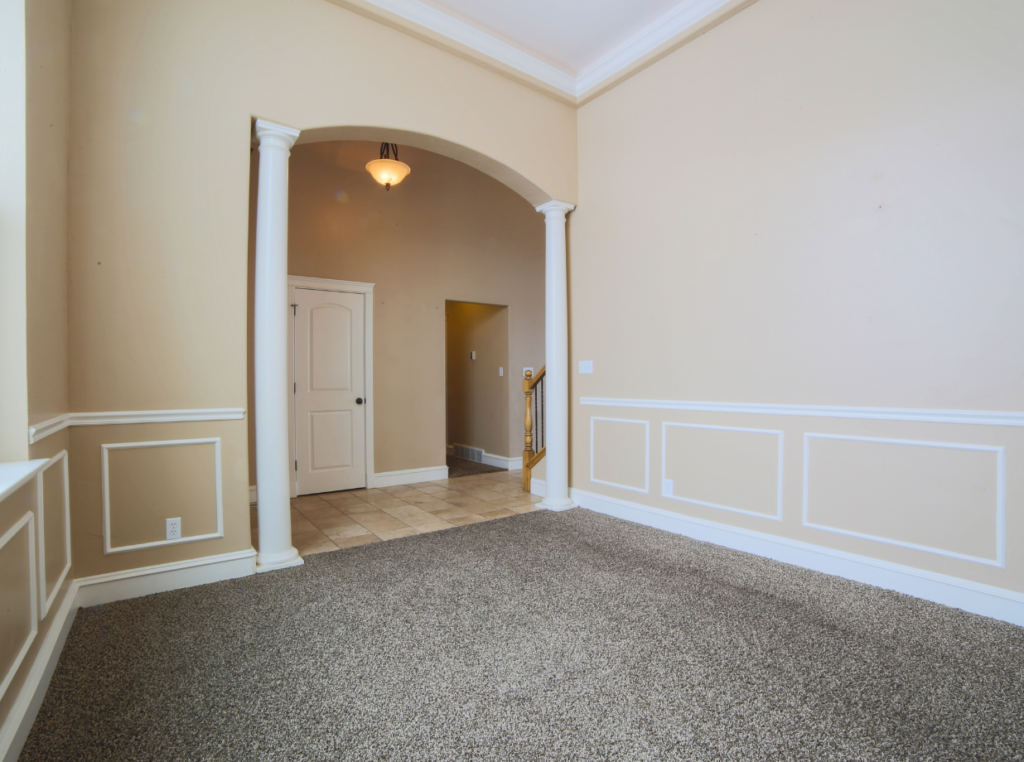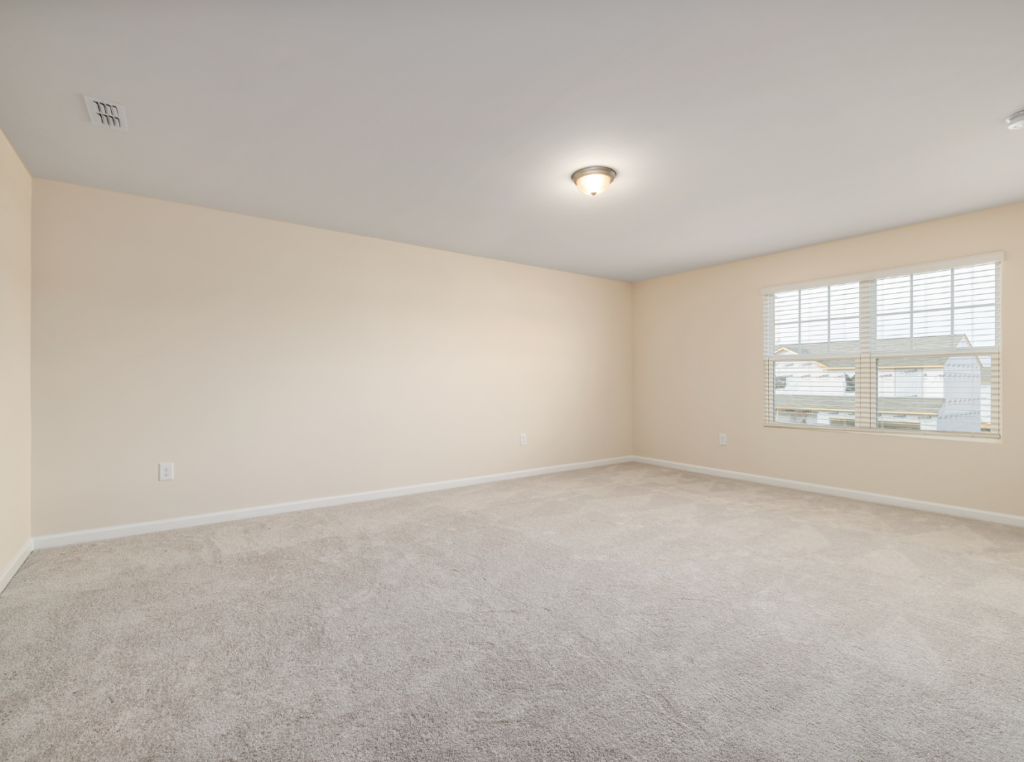Carpet installation is intricate, requiring careful consideration of a room’s unique features. In Huntsville, Alabama, evaluating the room’s layout is crucial for success. Identifying obstacles like irregular shapes, tight spaces, and uneven surfaces helps develop a plan that addresses these challenges.
Irregular shapes, such as angled walls and alcoves, complicate carpet fitting and need specialized techniques. Tight spaces limit maneuverability, and uneven surfaces affect carpet stability and appearance. Thorough evaluation allows the installation team to create a plan that considers the room’s purpose, aesthetic, and carpet requirements. This ensures the final installation meets client expectations and enhances the room’s design.
Key Takeaways
- Assess the unique challenges of the irregularly shaped room before starting the carpet installation process.
- Measure and plan carefully to ensure the carpet fits the irregular shapes of the room accurately.
- Select the right carpet type and pile that will work best for the irregularly shaped room.
- Prepare the subfloor properly to ensure a smooth and even installation of the carpet.
- Cut and fit the carpet precisely to accommodate corners, alcoves, and angled walls in the room.
Measuring and Planning for Irregular Shapes

Accurate measurements and detailed planning are essential for a successful carpet installation, especially when dealing with irregular shapes. Developing a detailed plan to ensure accurate measurements is a crucial step in the process. This involves utilizing specialized tools and techniques to capture the room’s dimensions accurately, accounting for any unique angles, curves, or other irregularities in the layout.
One of the key aspects of measuring and planning for irregular shapes is the use of specialized tools and techniques. This may include the use of laser measuring devices, which can provide precise measurements of the room’s dimensions, even in the presence of complex shapes or obstacles. Additionally, the use of templates or pattern-making techniques can help the installation team to visualize the layout and plan the cutting and fitting of the carpet more effectively.
Accounting for the unique angles, curves, or other irregularities in the room’s layout is also essential. This may involve the use of specialized cutting techniques, such as mitering or pattern matching, to ensure a seamless and professional-looking finish. By carefully considering these irregularities and incorporating them into the overall plan, the installation team can ensure that the carpet fits the room’s dimensions perfectly, creating a cohesive and visually appealing result.
Selecting the Right Carpet Type and Pile
Choosing the right carpet type and pile is a crucial decision that can have a significant impact on the overall success of the installation. Evaluating the room’s foot traffic and usage patterns is essential in determining the appropriate carpet type and pile that can withstand the demands of the space. Additionally, considering the visual impact of the carpet’s texture and color on the room’s overall aesthetic is an important factor in the selection process.
When evaluating the room’s foot traffic and usage patterns, the installation team must consider factors such as the level of activity, the presence of furniture or other heavy objects, and the potential for spills or stains. Based on this assessment, they can select a carpet type and pile that is durable, stain-resistant, and able to withstand the demands of the space. This may involve choosing a higher-quality carpet with a dense pile or a more resilient fiber type, such as nylon or polyester.
The visual impact of the carpet’s texture and color on the room’s overall aesthetic is also an important consideration. The carpet’s texture can influence the perceived warmth and comfort of the space, while the color can have a significant impact on the room’s overall mood and ambiance. By carefully selecting a carpet that complements the room’s existing design elements, the installation team can create a cohesive and visually appealing result that enhances the overall aesthetic of the space.
Preparing the Subfloor for a Smooth Installation
Preparing the subfloor for a smooth carpet installation is a critical step that can have a significant impact on the final result. Assessing the condition of the subfloor and addressing any issues is essential in ensuring a stable and level foundation for the new carpet. Ensuring the subfloor is clean, free of debris, and level is also crucial in creating a smooth and even surface for the carpet installation.
When assessing the condition of the subfloor, the installation team must carefully inspect the surface for any signs of damage, unevenness, or other issues that could affect the stability and appearance of the new carpet. This may involve addressing cracks, holes, or uneven surfaces, as well as ensuring that the subfloor is free of any debris or contaminants that could interfere with the adhesion of the carpet.
Applying the appropriate underlayment or padding is another important aspect of preparing the subfloor. The underlayment or padding can provide additional cushioning and support, helping to create a stable and comfortable surface for the carpet. The type of underlayment or padding used will depend on the specific requirements of the room and the carpet being installed, and the installation team must carefully select the appropriate materials to ensure a successful outcome.
By taking the time to thoroughly prepare the subfloor, the installation team can create a solid foundation for the new carpet, ensuring a smooth and even installation that will last for years to come. This attention to detail can also help to prevent common issues, such as buckling, shifting, or uneven wear, that can arise from an improperly prepared subfloor.
Cutting and Fitting the Carpet Precisely
| Challenges | Solutions |
|---|---|
| Irregular room shapes | Use templates to create custom carpet cuts |
| Uneven subfloor | Level the subfloor before installation |
| Matching patterns | Carefully plan pattern alignment |
| Complex corners | Utilize specialized tools for precise cuts |
Cutting and fitting the carpet precisely is a critical step in the installation process, particularly when dealing with irregular shapes or tight spaces. Developing a strategic plan for cutting and fitting the carpet is essential in ensuring a seamless and professional-looking result. Utilizing specialized tools and techniques to achieve clean, accurate cuts is also crucial in creating a high-quality installation.
When developing a strategic plan for cutting and fitting the carpet, the installation team must carefully consider the room’s dimensions, the location of any obstacles or irregularities, and the best way to minimize waste and maximize the use of the available carpet. This may involve the use of templates, pattern-matching techniques, or specialized cutting tools to ensure that the carpet fits the room’s unique shape and dimensions perfectly.
The use of specialized tools and techniques is also essential in achieving clean, accurate cuts. This may include the use of sharp utility knives, straight edges, or specialized carpet-cutting tools that can provide precise, clean-edged cuts. Additionally, the installation team may need to employ techniques such as seaming or pattern matching to ensure a seamless and visually appealing finish, particularly in areas with complex shapes or tight spaces.
By carefully planning and executing the cutting and fitting process, the installation team can ensure that the carpet is installed with precision and attention to detail. This not only enhances the overall appearance of the finished product but also helps to ensure the long-term durability and stability of the carpet installation.
Navigating Corners, Alcoves, and Angled Walls

Navigating corners, alcoves, and angled walls can be one of the most challenging aspects of a carpet installation, particularly when dealing with irregular room shapes. Identifying and addressing the challenges posed by these unique features is essential in ensuring a successful and professional-looking result. Employing creative solutions to seamlessly integrate the carpet into these areas is also crucial in achieving a polished finish.
When identifying the challenges posed by corners, alcoves, and angled walls, the installation team must carefully assess the room’s layout and consider factors such as the angle of the walls, the presence of any obstacles or obstructions, and the overall dimensions of the space. This may involve the use of specialized cutting techniques, such as mitering or pattern matching, to ensure that the carpet fits the room’s unique shape and dimensions.
Employing creative solutions to seamlessly integrate the carpet into these areas is also essential. This may involve the use of custom-cut borders or transition pieces to create a smooth and seamless transition between the carpet and the surrounding surfaces. Additionally, the installation team may need to utilize specialized installation methods, such as the use of adhesives or mechanical fasteners, to ensure that the carpet is firmly anchored in place and will not shift or buckle over time.
By navigating these unique features with skill and creativity, the installation team can ensure that the final result is not only visually appealing but also highly functional and durable. This attention to detail and problem-solving can help to elevate the overall quality of the carpet installation and create a truly exceptional finished product.
Securing the Carpet Firmly in Place
Securing the carpet firmly in place is a critical step in the installation process, as it ensures the long-term stability and durability of the finished product. Selecting the appropriate adhesive or installation method for the room’s conditions is essential in achieving a secure and reliable installation. Applying the adhesive or securing the carpet with precision and care is also crucial in ensuring a professional-looking result.
When selecting the appropriate adhesive or installation method, the installation team must carefully consider the room’s specific conditions, such as the type of subfloor, the level of foot traffic, and the presence of any unique features or challenges. This may involve the use of a variety of adhesives, including pressure-sensitive, wet-set, or double-stick adhesives, or the use of mechanical fasteners, such as tack strips or staples, to secure the carpet in place.
Applying the adhesive or securing the carpet with precision and care is also essential in ensuring a successful installation. This may involve the use of specialized tools and techniques, such as the use of a roller or a trowel to evenly distribute the adhesive, or the careful placement of mechanical fasteners to ensure a secure and stable installation. Additionally, the installation team must take care to ensure that the carpet is firmly anchored in place and will not shift or buckle over time, as this can compromise the overall appearance and durability of the finished product.
By securing the carpet firmly in place, the installation team can help to ensure that the finished product will withstand the demands of the space and maintain its appearance and functionality for years to come. This attention to detail and precision can also help to prevent common issues, such as premature wear or damage, that can arise from an improperly installed carpet.
Blending Seams for an Invisible Transition
Blending seams for an invisible transition is a critical aspect of a successful carpet installation, particularly when dealing with large or complex spaces. Identifying the best placement and techniques for carpet seams is essential in creating a seamless and visually appealing finish. Carefully aligning and blending the seams to create a seamless appearance is also crucial in achieving a professional-looking result.
When identifying the best placement and techniques for carpet seams, the installation team must carefully consider factors such as the room’s layout, the direction of foot traffic, and the overall aesthetic of the space. This may involve the use of specialized cutting techniques, such as pattern matching or seaming, to ensure that the seams are placed in the most inconspicuous locations and blend seamlessly with the surrounding carpet.
Carefully aligning and blending the seams to create a seamless appearance is also essential in achieving a professional-looking result. This may involve the use of specialized tools and techniques, such as the use of a seam roller or a seam iron, to ensure that the seams are properly aligned and bonded. Additionally, the installation team may need to employ techniques such as shading or blending to further minimize the visibility of the seams and create a cohesive and visually appealing finish.
By blending seams for an invisible transition, the installation team can help to ensure that the finished product is not only highly functional but also visually stunning. This attention to detail and craftsmanship can help to elevate the overall quality of the carpet installation and create a truly exceptional finished product.
Troubleshooting Common Issues and Solutions
Carpet installation is a complex and multi-faceted process, and even the most experienced installation teams may encounter unexpected challenges or issues during the course of a project. Recognizing and addressing common problems that may arise during the installation is essential in ensuring a successful and satisfactory outcome. Developing strategies to overcome unexpected challenges or obstacles is also crucial in providing a high-quality service to clients.
When it comes to troubleshooting common issues, the installation team must be prepared to address a wide range of potential problems, from uneven subfloors and irregular room shapes to issues with the carpet itself, such as bubbling, wrinkling, or discoloration. By being proactive in identifying and addressing these issues, the team can help to minimize the impact on the overall installation process and ensure that the final result meets the client’s expectations.
In some cases, the complexity or severity of the issues encountered may require the expertise of a professional carpet installer or other specialist. Providing guidance on when to seek professional assistance for complex or difficult installations is an important aspect of troubleshooting, as it can help to ensure that the client receives the best possible service and that the installation is completed to the highest standards.
By developing a comprehensive understanding of common issues and solutions, and by being willing to seek professional assistance when necessary, the installation team can help to ensure that every carpet installation project is a success, regardless of the unique challenges or obstacles that may arise.
Frequently Asked Questions

Installing carpet in irregularly shaped rooms can be challenging due to corners, uneven edges, and varied flooring materials. Our FAQs address common challenges, offer practical tips, recommend essential tools, and highlight mistakes to avoid. This guide will help ensure a successful carpet installation in Huntsville, Alabama.
What are some common challenges faced when installing carpet in irregularly shaped rooms in Huntsville, Alabama?
Installing carpet in irregularly shaped rooms presents challenges such as fitting the carpet around corners, dealing with uneven edges, and ensuring a seamless transition between different flooring materials.
What are some tips for successfully installing carpet in irregularly shaped rooms?
Tips for successfully installing carpet in irregularly shaped rooms include carefully measuring and planning the layout, using seam tape and a power stretcher to ensure a tight fit, and considering custom carpet cutting for unique shapes.
What tools and materials are essential for installing carpet in irregularly shaped rooms?
Essential tools and materials for installing carpet in irregularly shaped rooms include a measuring tape, chalk line, utility knife, seam tape, power stretcher, knee kicker, and carpet cutting tools.
What common mistakes should be avoided when installing carpet in irregularly shaped rooms?
Common mistakes to avoid when installing carpet in irregularly shaped rooms include not properly preparing the subfloor, neglecting to acclimate the carpet to the room’s temperature and humidity, and failing to properly secure seams and edges.
